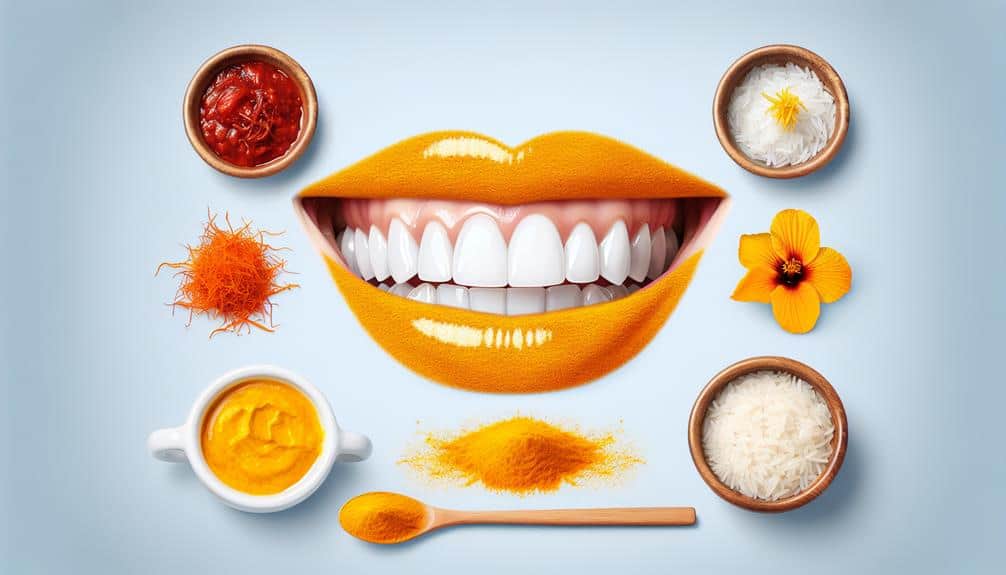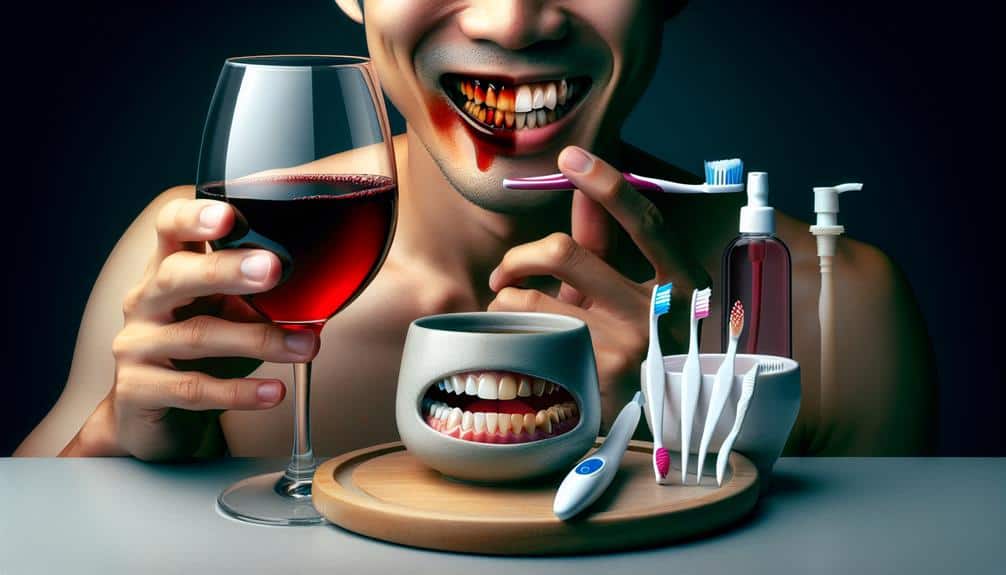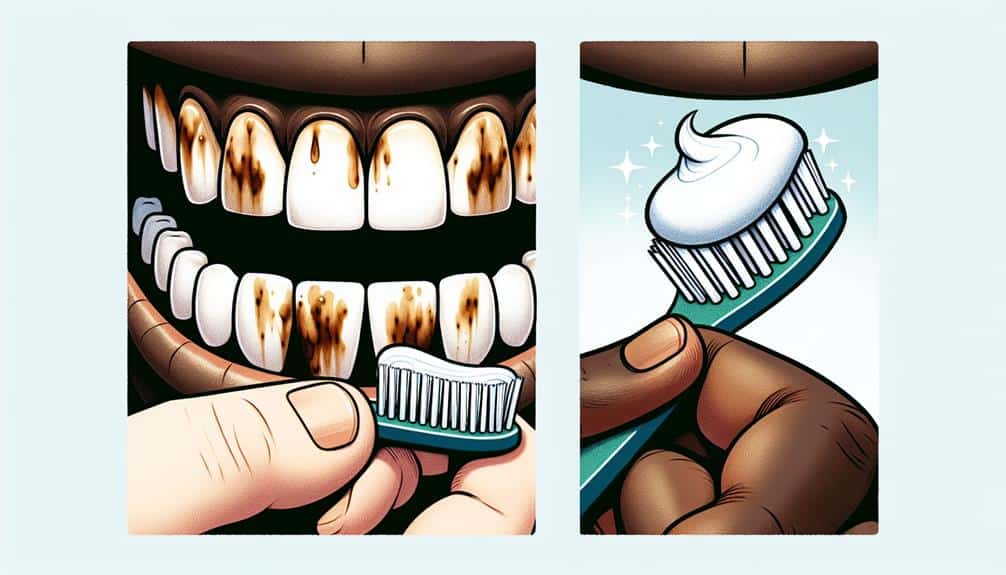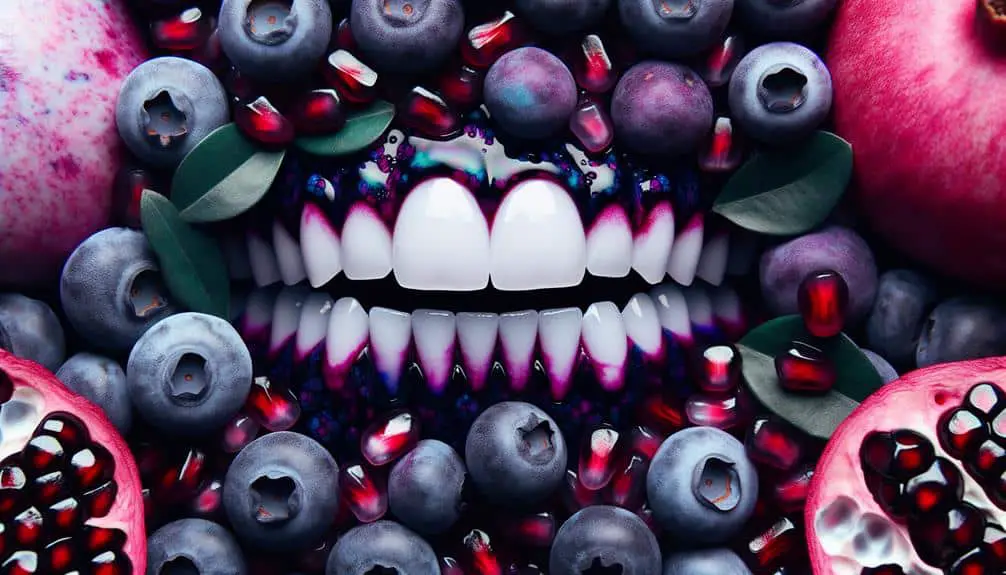If you want to avoid saffron teeth discoloration, steer clear of coffee, red wine, curry, tomato sauce, balsamic vinegar, berries, soy sauce, and beets. These foods and drinks contain pigments or acids that can stain your teeth over time. Saffron, when consumed in moderation, can also contribute to teeth discoloration. Understanding these culprits is essential for maintaining a bright smile.
Key Points
- Saffron can cause teeth discoloration due to its staining effect.
- High saffron intake can lead to visible stains on teeth.
- Saffron's pigmentation can adhere to tooth enamel, causing discoloration.
- Consuming saffron in moderation helps reduce the risk of teeth staining.
- Regular dental hygiene practices are essential to prevent saffron-induced teeth discoloration.
Coffee
If you regularly consume coffee, you may notice that it's one of the primary culprits for causing teeth discoloration. Coffee stains can be stubborn and often cling to the enamel of your teeth, leading to a yellow or brownish tint over time. This discoloration occurs due to the high levels of chromogens found in coffee, which are intense pigment particles that easily attach to the porous surface of your teeth.
Caffeine addiction often goes hand in hand with frequent coffee consumption, further exacerbating the risk of teeth discoloration. As you indulge in your daily cup of coffee, the dark liquid seeps into the tiny cracks and ridges of your enamel, leaving behind traces of pigments that gradually build up and result in unsightly stains on your teeth.
To combat coffee-induced teeth discoloration, consider reducing your coffee intake or using a straw to minimize direct contact between the coffee and your teeth. Additionally, regular dental cleanings and whitening treatments can help remove stubborn coffee stains and restore your smile to its natural brilliance.
Red Wine
Red wine is a common culprit for teeth discoloration due to its high tannin content and deep pigmentation. Tannins are natural compounds found in grape skins, seeds, and stems, which can adhere to tooth enamel, causing stains over time. The deep red color of red wine also contains chromogens, intense pigments that easily attach to teeth, further contributing to discoloration.
When enjoying red wine, consider pairing it with foods that can help reduce its staining effects. Foods like cheese, which is rich in calcium, can create a protective layer on the teeth, minimizing the wine's contact with enamel. Additionally, incorporating crunchy fruits and vegetables like apples and carrots into your red wine pairing can help naturally cleanse the teeth.
Despite its potential for teeth discoloration, red wine also offers health benefits when consumed in moderation. It contains antioxidants like resveratrol, which may promote heart health and reduce inflammation. Balancing the enjoyment of red wine with proper oral hygiene practices can help mitigate its staining effects while still allowing you to savor its taste and potential health benefits.
Curry
Curry can lead to teeth discoloration due to its staining effect.
To prevent saffron discoloration, consider consuming curry in moderation.
Explore alternative seasoning options to minimize the impact of curry on your teeth.
Currys Staining Effect
The staining effect of curry on teeth is a common concern due to its vibrant color and strong pigmentation. Curry recipes often contain turmeric, a key ingredient known for its vibrant yellow hue. When combined with saffron, another common spice in curry blends, the intensity of the color increases, potentially leading to teeth discoloration.
Despite the numerous health benefits associated with saffron, such as its antioxidant properties and potential mood-enhancing effects, its staining effect on teeth can be a drawback. It's essential to consume curry in moderation and practice good oral hygiene to minimize the risk of teeth discoloration. Additionally, rinsing your mouth with water after eating curry dishes can help prevent the pigments from adhering to the teeth.
Preventing Saffron Discoloration
To prevent saffron discoloration caused by curry, consider incorporating mouth rinsing with water into your post-meal oral care routine. Ensuring proper dental care and oral hygiene practices can considerably reduce the risk of staining on your teeth. Here are three essential tips to help you prevent saffron discoloration:
- Use a straw: When consuming curry dishes, using a straw can help minimize direct contact between the saffron-containing curry and your teeth.
- Brush your teeth: Brushing your teeth after consuming curry can help remove any saffron residue on the tooth surface.
- Regular dental check-ups: Schedule regular dental check-ups to monitor any potential saffron discoloration and address it promptly through professional cleaning or treatment.
Alternatives to Curry
Considering dietary changes can be effective in preventing teeth discoloration caused by certain foods and drinks. When looking for alternatives to curry to avoid saffron teeth discoloration, there are various spice alternatives and flavor substitutions you can consider.
Instead of using curry, you may opt for spices like turmeric, paprika, or cumin, which provide similar flavor profiles without the risk of staining your teeth. These spice alternatives can still add depth and complexity to your dishes without causing discoloration.
Additionally, exploring flavor substitutions such as garam masala, coriander, or cardamom can help you achieve the desired taste in your meals while safeguarding your dental aesthetics. By making simple swaps in your cooking, you can enjoy flavorful dishes while maintaining a bright smile.
Tomato Sauce
Tomato sauce can contribute to teeth discoloration due to its acidity and staining properties.
The high acid content in tomato sauce can erode the enamel, making teeth more susceptible to staining from other foods and drinks.
To minimize the discoloration effects, consider consuming tomato sauce in moderation and practicing good oral hygiene habits.
Acidic Foods
Consuming acidic foods such as tomato sauce can contribute to teeth discoloration due to their erosive nature on enamel. These foods can wear down the protective layer of your teeth, making them more prone to staining and discoloration. To prevent saffron teeth, consider the following:
- Limit Citrus Fruits: Citrus fruits are highly acidic and can lead to enamel erosion, which in turn can cause teeth discoloration.
- Watch Vinegar Intake: Vinegar, commonly found in salad dressings and pickles, is acidic and can erode tooth enamel over time.
- Balance Acidity: Maintain a balanced diet with acidic foods like tomato sauce in moderation to reduce the risk of teeth discoloration.
Staining Beverages
To prevent teeth discoloration caused by staining beverages like tomato sauce, it's essential to be mindful of their impact on your dental enamel. Tomato sauce contains acidic components that can lead to discoloration over time.
Similarly, tea stains and soda discoloration are also common culprits in causing teeth stains. The dark pigments present in tomato sauce can adhere to the enamel, resulting in a yellowish or brownish tint on the teeth.
To minimize the effects of staining beverages, it's advisable to consume them in moderation and rinse your mouth with water after consumption. Regular dental hygiene practices such as brushing and flossing can also help prevent and reduce teeth discoloration caused by these beverages.
Balsamic Vinegar
Balsamic vinegar, a common ingredient in many dishes, can contribute to teeth discoloration over time due to its acidic nature. When consumed regularly, balsamic vinegar can lead to yellowing or staining of the teeth.
Here are some points to take into account:
- Acidic Content: Balsamic vinegar contains acetic acid, which can erode the enamel of your teeth, making them more susceptible to staining.
- Pigment Intensity: The dark color of balsamic vinegar can adhere to the enamel of your teeth, causing discoloration over time.
- Usage in Foods: Balsamic vinegar is often used in vinegar marinades and salad dressings, which means it frequently comes into contact with your teeth during meals.
To mitigate the effects of balsamic vinegar on your teeth, consider rinsing your mouth with water after consuming it or using a straw to minimize contact with your teeth. Additionally, regular dental hygiene practices such as brushing and flossing can help prevent or reduce teeth discoloration caused by balsamic vinegar.
Berries
The pigments found in berries have the potential to cause teeth discoloration, especially when consumed regularly. Berries such as blueberries, blackberries, and raspberries contain chromogens, intense color pigments that can stick to the enamel of your teeth over time. These pigments are highly pigmented and can leave a stain on your teeth, leading to discoloration if proper oral hygiene isn't maintained.
To minimize the risk of teeth discoloration from berries, consider consuming them in moderation. Additionally, after eating berries, rinse your mouth with water to help reduce the staining effect on your teeth. Regular brushing and flossing can also aid in preventing long-term discoloration.
Incorporating berries into smoothie recipes or fruit salad ideas can be a delicious way to enjoy their health benefits while minimizing their potential to cause teeth discoloration. When preparing smoothies or fruit salads, consider including a variety of fruits to dilute the impact of the pigments on your teeth.
Soy Sauce
Consuming soy sauce can contribute to teeth discoloration due to its dark pigment and acidic nature, which can stain and erode the enamel over time. While soy sauce adds depth of flavor to dishes, it's essential to be cautious of its effects on dental health.
Here are key points to keep in mind:
- Fermented foods, pickled foods: Soy sauce is a fermented condiment, along with other pickled foods, containing compounds that can adhere to the teeth, leading to discoloration over time.
- Umami flavors, savory dishes: Soy sauce is renowned for its umami taste, commonly used in savory dishes. However, the rich flavor comes with the consequence of potential teeth staining.
- Enamel erosion: The acidic nature of soy sauce can gradually wear down the protective enamel layer of the teeth, making them more susceptible to discoloration and decay if consumption is excessive.
To maintain a bright smile while enjoying soy sauce, it's advisable to rinse your mouth with water after consuming it and to practice good oral hygiene habits.
Beets
When consuming beets, be mindful of their potential to cause teeth discoloration due to their pigmentation and acidic nature. Beets contain strong pigments that can adhere to the enamel of your teeth, leading to stains over time. Beet juice, with its vibrant red color, is particularly potent in causing discoloration. The acidity in beets can also weaken the enamel, making it more susceptible to staining from other foods and drinks.
If you enjoy saffron cocktails or dishes that incorporate beets, consider rinsing your mouth with water after consuming them to help prevent staining. Additionally, brushing your teeth about 30 minutes after eating beets can help remove any pigments that may have started to adhere to your teeth.
To minimize the risk of teeth discoloration from beets, moderation is key. While the nutritional benefits of beets are plenty, being aware of their staining potential can help you enjoy them without compromising the whiteness of your teeth.
Saffron
To prevent teeth discoloration, consider rinsing your mouth with water after enjoying saffron-infused dishes or drinks. Saffron, a prized spice derived from the Crocus sativus flower, is known for its vibrant color and distinct flavor.
Here are some key points to keep in mind when dealing with saffron:
- Saffron Recipes: Incorporating saffron into your cooking can add a unique taste and a beautiful golden hue to your dishes. From paella to risotto, saffron is a versatile ingredient in various cuisines around the world.
- Health Benefits: Saffron isn't only used for its culinary properties but also for its potential health benefits. It's rich in antioxidants and may have anti-inflammatory properties that could positively impact overall well-being.
- Saffron Cultivation and Harvesting Techniques: Saffron cultivation is a delicate process that requires meticulous attention to detail. The harvesting of saffron threads is done by hand, making it one of the most labor-intensive crops globally.
Frequently Asked Questions
Can Saffron Teeth Discoloration Be Permanent?
If saffron teeth discoloration occurs, treatment options vary. Long term effects depend on the cause. Prevention methods include limiting exposure to staining agents. Cosmetic dentistry might offer solutions for persistent discoloration, but consult a professional for guidance.
Are There Any Specific Toothpaste or Mouthwash Products That Can Help Prevent Saffron Teeth Discoloration?
When it comes to preventing saffron teeth discoloration, explore toothpaste options with whitening properties. Incorporate mouthwash recommendations that target stains. Consistent use of these products may help maintain a brighter smile and combat discoloration.
How Long Does It Typically Take for Saffron Teeth Discoloration to Fade?
Typically, saffron teeth discoloration fades over time, depending on the severity and individual factors. It may take several weeks to months. Over-the-counter remedies like whitening toothpaste can help, or professional treatment may be necessary for quicker results. Lifestyle changes and dietary adjustments can also aid in the fading process.
Are There Any Home Remedies That Can Help Remove Saffron Stains From Teeth?
To effectively remove saffron stains from teeth, try natural remedies like baking soda and hydrogen peroxide mix. Prevention tips include daily habits like brushing thoroughly and avoiding staining foods. These methods can be quite effective in restoring your teeth's natural shine.
Is Saffron Teeth Discoloration More Common in Certain Age Groups or Demographics?
Age groups and demographics influence saffron teeth discoloration prevalence. Cultural differences and dietary habits play roles. Certain groups exhibit higher occurrences. Understanding these factors aids in addressing and preventing saffron stains for improved oral health.




